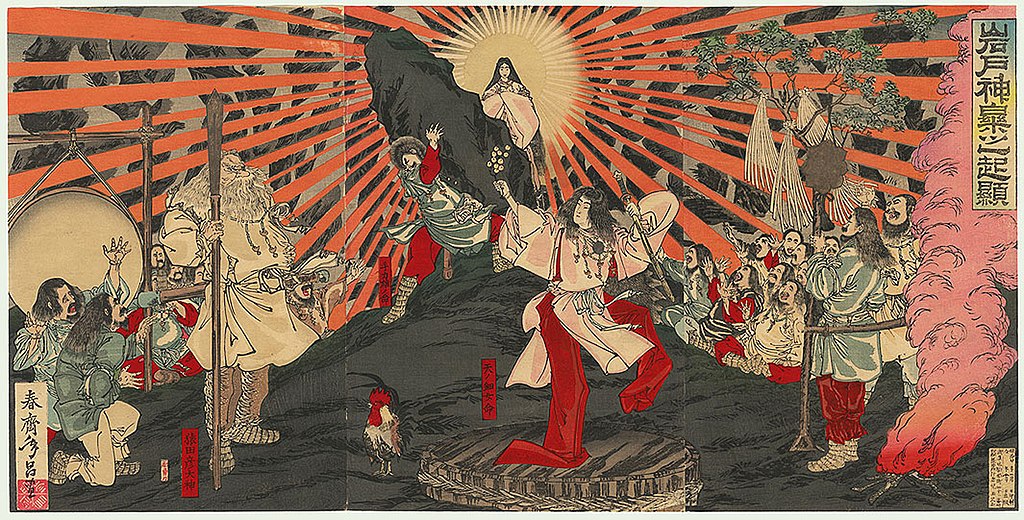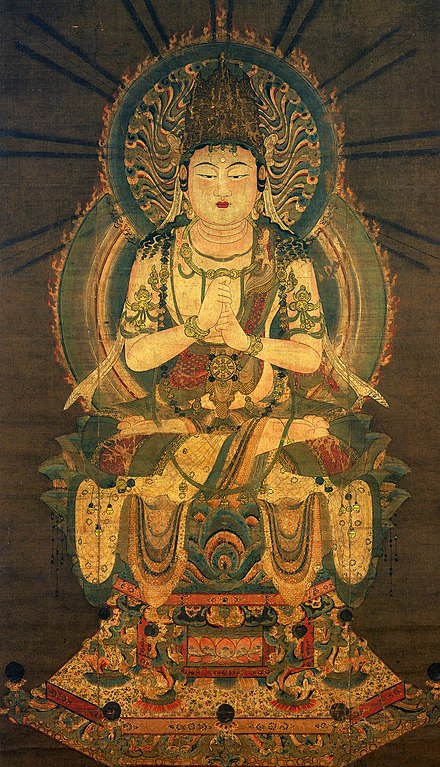Esoteric Buddhism as taught by Kukai is associated with the teachings contained in the Mahavairocana Sutra (Jap Dainichi-kyo) from the mid-7th century, and the Vajrasekhara Sutra (Jap Kongocho-kyo) from the late-7th century, he received from Huiguo when he studied with him in 805 during his visit to China. The name of the school Kukai founded – Shingon – is the Japanese pronunciation of the Chinese chen-yen (zhenyan). It originated in India as Mantrayana – the Mantra Vehicle – and was transmitted separately to Tibet (where it is referred to as Vajrayana or tantrism) and China. In China, however, it did not survive the persecution of Buddhism by the Tang emperor Wuzong in 842-845.

Yoshito Hakeda notes that “Mahavairocana (Dainichi) means “Great Sun” … The Great Sun Goddess (Amaterasu) is the central figure of the Shinto pantheon, and the parallel between the two is too obvious to need stressing. Later, with the development of Ryobu Shinto, Amaterasu came widely to be recognized of Dainichi Nyorai (Tathagata), and Kukai could hardly fail to reach a comparable conclusion.”
Dainishi, in fact, was already present in Nara. The Todai-ji temple, which was the most imposing religious institution in Japan at the time, already housed the world’s largest bronze statue of Dainishi.
Early on, according to Dr Gene Reeves, the name Vairocana had been associated with Sakyamuni describing him as dwelling in a place called “Always Tranquil Light.” Before Kukai started teaching, Mahavairocana had been associated with the Kegon (Huayan) school. Though Dainishi was the central Buddha of the Kegon school, however, he was still conceived as a Celestial Buddha, not as a “Buddha-as-cosmos who expounds the truth.”

Hakeda explains that, though already well-known both in China and in Japan, “Mahavairocana had not always been clearly recognized as the central Buddha in the Esoteric tradition. It was Subhakarasimha who introduced Esoteric Buddhism into China and who translated the Mahavairocana Sutra. Until the time of Hui-kuo, however, Mahavairocana was apparently not rigorously upheld as the Dharmakaya Buddha … The assertion that Mahavairocana is the Dharmakaya appears first in the commentary on the Mahavairocana Sutra expounded by Subhakarasimha and written down by his disciple I-hsing, but the same commentary also identifies Mahavairocana with the Sambhogakaya. Thus it was probably Hui-kuo who stressed the identity of Mahavairocana with the timeless Dharmakaya Buddha and who also taught that the Mahavairocana Sutra and Vajrasekhara Sutra were preached by the Dharmakaya Mahavairocana himself rather than by the historical Buddha, as Buddhists had always held.” Though he left no writing, Huiguo could have held this view in his oral transmission to Kukai.
Hakeda writes: “Hui-kuo left no written exposition of his views, so that it was actually Kukai who undertook the first systematic treatment of his master’s ideas and of Chinese Esoteric Buddhism in general. However, Kukai says nothing about the identity of Mahavairocana and the Dharmakaya in his earlier writings … It was not until nearly ten years later, in the “Difference Between Exoteric and Esoteric,” that Kukai defined Mahavairocana as the Dharmakaya.”
Hakeda continues: “The identification of Mahavairocana with the Dharmakaya was a great leap in Buddhist speculation, for the Dharmakaya hitherto had generally been regarded as formless, imageless, voiceless, and totally beyond conceptualization … By defining Mahavairocana as the Dharmakaya, Kukai identified Mahavairocana with the eternal Dharma, the uncreated, imperishable, beginningless, and endless Truth. It is the realization of this truth which made Gautama the Enlightened One … The sun is the source of light and warmth, the source of life. Similarly, Mahavairocana is the Great Luminous One at the center of a multitude of Buddhas, bodhisattvas, and powers; He is the source of enlightenment and the unity underlying all variety. To attain enlightenment means to realize Mahavairocana, the implication being that Mahavairocana is originally within man. Hence Kukai called Mahavairocana the “enlightened mind” (bodhicitta), a synonym for Suchness, or the element of “original enlightenment” within man. On this immanence of the Dharmakaya Kukai says: “Where is the Dharmakaya? It is not far away; it is in our body. The source of wisdom? In our mind; indeed, it is close to us!” Thus it is that Kukai speaks of “attaining enlightenment in this very existence.”
Source: Yoshito S. Hakeda – Kukai: Major Works

